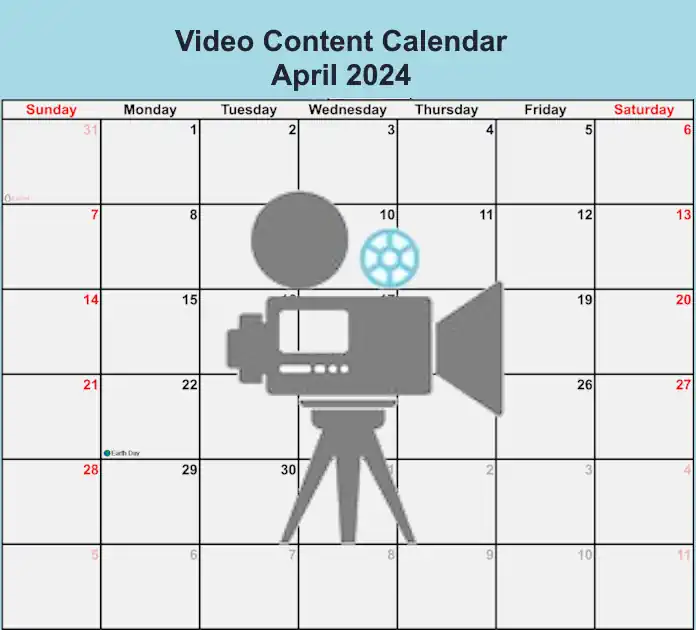In today’s digital landscape, video marketing has become an indispensable tool for businesses looking to engage their audience and drive conversions. However, maintaining a consistent and compelling video presence can be challenging without a well-structured plan in place. This is where a video content calendar comes into play, serving as a roadmap to elevate your video marketing strategy and ensure your brand’s success.

Understanding the Benefits of a Video Content Calendar
A video content calendar offers numerous benefits that can help you streamline your marketing efforts and achieve your goals. It ensures consistency in your brand messaging and content quality, allowing you to build a recognizable and trustworthy brand image. For example, if you’re a fitness brand, consistently releasing workout videos and nutrition tips weekly can help establish your authority in the industry.
A content calendar enables better planning and resource allocation, as you can schedule your video production and distribution in advance. This allows you to optimize your budget and be sure that you or your team is working efficiently towards your marketing objectives. By delivering regular, high-quality video content, you can increase audience engagement and foster loyalty among your viewers.
Key Elements of an Effective Video Content Calendar
To create an effective video content calendar, you need to consider several key elements. Start by defining your target audience and understanding their preferences, interests, and pain points. This will help you identify the right video formats and topics that resonate with your viewers. For instance, if you’re targeting millennials, short-form, snackable content like Instagram Reels or TikTok videos might be more appealing than lengthy tutorials.
Next, determine the optimal posting frequency and schedule based on your audience’s behavior and platform algorithms. Consistency is crucial, but you also need to be sure that you’re not overwhelming your viewers with too much content. A good rule of thumb is to post at least one video per week, while also leaving room for flexibility and real-time content creation.
Finally, align your video content with your overall marketing campaigns and product launches. This will help you create a cohesive brand experience and maximize the impact of your video marketing efforts.
Steps to Create Your Video Content Calendar
Creating a video content calendar involves several steps. Begin by conducting a content audit and gap analysis to identify areas where you can improve your existing video content and fill in the gaps with new ideas. Then, brainstorm video ideas and themes that align with your brand’s message and target audience’s interests.
Once you have a list of potential video topics, prioritize and schedule them based on their relevance and urgency. Assign responsibilities and deadlines to ensure that your team is on track and accountable for their tasks. To streamline the process, consider using a content calendar tool or template, such as Trello, Asana, or Google Sheets.

Video Content Checklist
When planning your video content strategy, consider the following steps and questions:
- Define your target audience:
- Who is your ideal viewer?
- What are their demographics, interests, and pain points?
- What type of video content do they consume and engage with?
- Set your video content goals:
- What do you want to achieve with your video content (e.g., brand awareness, lead generation, sales)?
- How will you measure the success of your video marketing efforts?
- Conduct a video content audit:
- What videos have you already created?
- Which videos performed well, and which ones didn’t?
- Are there any gaps in your video content that you need to fill?
- Determine your video content themes and topics:
- What topics align with your brand’s message and expertise?
- What video formats will you use (e.g., tutorials, interviews, product demos)?
- How can you create video content that addresses your target audience’s needs and interests?
- Establish a video content creation and distribution schedule:
- How frequently will you publish new videos?
- What platforms will you use to distribute your video content (e.g., YouTube, social media, website)?
- Who will be responsible for creating, editing, and publishing the videos?
- Allocate resources and budget:
- What resources (e.g., time, personnel, equipment) do you need to execute your video content strategy?
- How much budget can you allocate to video production and promotion?
- Plan for video optimization and repurposing:
- How can you optimize your videos for search engines and social media?
- Can you repurpose your video content into different formats (e.g., short clips, GIFs) to maximize its reach and value?
- Measure and analyze your video performance:
- What metrics will you track to gauge the performance of your videos (e.g., views, engagement, conversions)?
- How will you use data and insights to refine and improve your video content strategy over time?
By answering these questions and following these steps, you can create a comprehensive and effective video content strategy that helps you achieve your marketing goals and connect with your target audience through engaging and valuable video content.
Tips for Optimizing Your Calendar
To get the most out of your video content calendar, regularly review and adjust it based on performance metrics. Track your video views, engagement rates, and conversion rates to identify what’s working and what’s not. Use this data to form your future content creation and optimization efforts.
Incorporate user-generated content and collaborations into your video content calendar. This can help you expand your reach and tap into new audiences while also fostering a sense of community around your brand. For example, GoPro regularly features user-generated content in their social media videos, showcasing the amazing experiences their customers capture with their products.
Finally, stay attuned to trending topics and seasonal opportunities that you can leverage in your video content. This will help you stay relevant and attract more views and engagement.
Measuring the Success of Your Video Content Calendar
To gauge the success of your video content calendar, track key performance metrics such as views, engagement rates, and conversions. Analyze audience feedback and comments to gain valuable insights into what resonates with your viewers and what needs improvement.
Identify your top-performing videos and try to replicate their success by understanding what made them stand out. Continuously refine your video content calendar based on these insights to ensure that you’re delivering the most value to your audience and achieving your marketing goals.
Lila’s Story
Once upon a time, there was an aspiring fitness influencer named Lila. She had a passion for working out and helping others lead healthier lives. Excited to share her knowledge, Lila started posting fitness videos on her social media channels.

However, Lila’s content was inconsistent and lacked focus. She would post a yoga tutorial one day, a cardio workout the next, and then disappear for weeks without any updates. Her followers were confused and started losing interest.
Frustrated with her lack of progress, Lila sought advice from a successful fitness blogger. The blogger introduced her to the concept of a content calendar and helped her create a structured plan for her video content.
With her new content calendar in place, Lila began posting videos consistently, focusing on specific themes each week. She created a series of beginner-friendly workout routines, shared healthy meal prep ideas, and even featured inspiring client success stories.
As a result of her organized approach, Lila’s followers started engaging more with her content. They looked forward to her weekly videos and felt motivated by her consistent presence. Lila’s channel grew rapidly, and she became a trusted source of fitness advice in her community.
Lila’s story is a testament to the power of a well-crafted content calendar. By organizing her ideas and creating a structured plan, she was able to elevate her video marketing game and achieve the success she had always dreamed of.

An Example Content Calendar
Here’s a fictitious content calendar for a fitness brand called “FitLife” for the month of July:
Week 1 (July 1-7):
- Monday: “5-Minute Morning Stretch Routine” (Short video)
- Wednesday: “Healthy Meal Prep Ideas for Busy Professionals” (Blog post with embedded video)
- Friday: “Customer Spotlight: John’s Weight Loss Journey” (Video interview)
- Sunday: “Weekly Workout Challenge: 100 Squats a Day” (Social media post with video demonstration)
Week 2 (July 8-14):
- Tuesday: “The Benefits of High-Intensity Interval Training (HIIT)” (Explainer video)
- Thursday: “Q&A with FitLife’s Certified Nutritionist” (Live video on social media)
- Saturday: “10 Bodyweight Exercises You Can Do Anywhere” (Video tutorial)
Week 3 (July 15-21):
- Monday: “How to Stay Motivated on Your Fitness Journey” (Motivational video with client testimonials)
- Wednesday: “The Importance of Rest and Recovery” (Blog post with embedded video)
- Friday: “Product Showcase: FitLife’s New Resistance Band Set” (Product demo video)
- Sunday: “Weekly Workout Challenge: 1-Mile Run” (Social media post with video tips)
Week 4 (July 22-28):
- Tuesday: “Yoga for Beginners: A Step-by-Step Guide” (Video tutorial series, part 1)
- Thursday: “Healthy Snack Ideas for Pre and Post-Workout” (Blog post with embedded video)
- Saturday: “Customer Spotlight: Sarah’s Fitness Transformation” (Video interview)
Week 5 (July 29-31):
- Monday: “Yoga for Beginners: A Step-by-Step Guide” (Video tutorial series, part 2)
- Wednesday: “The Role of Mindset in Achieving Fitness Goals” (Motivational video with expert insights)
This content calendar includes a mix of video formats, such as short tutorials, customer spotlights, product demos, and motivational content, along with supporting blog posts. The topics cover various aspects of fitness, including workouts, nutrition, motivation, and mindset, catering to the interests and needs of the target audience. The consistent posting schedule and variety of content aim to keep the audience engaged and showcase the brand’s expertise in the fitness industry.
Wrapping Up
A well-crafted video content calendar is a game-changer for your video marketing strategy. Providing structure, consistency, and focus, can help you elevate your brand’s video presence and drive meaningful results.

Implement a content calendar for your video marketing efforts and experience the benefits firsthand – from increased engagement and loyalty to better resource allocation and marketing ROI. With a solid video content calendar in place, you’ll be well on your way to mastering the art of video marketing and achieving your business objectives.

